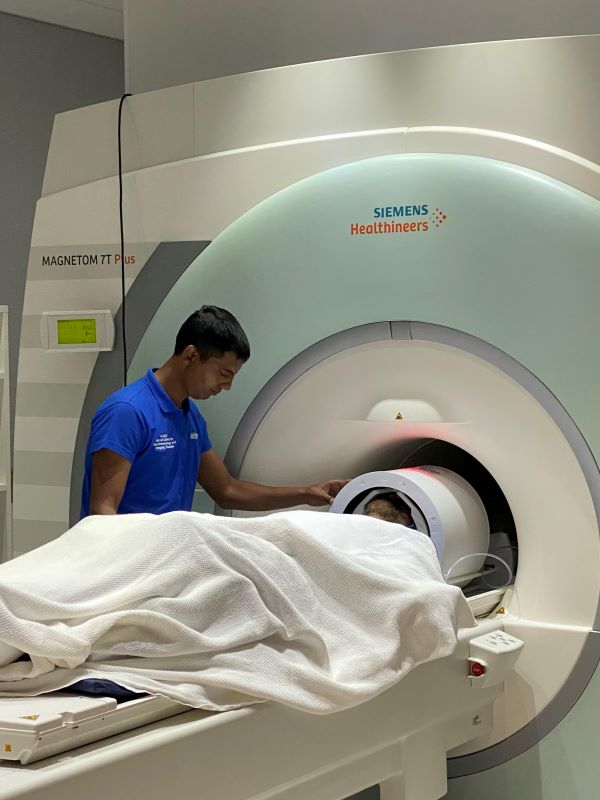Hippocampal subfield volume alterations and associations with severity measures in long COVID and ME/CFS: A 7T MRI study
Kiran Thapaliya; Sonya Marshall-Gradisnik; Natalie Eaton-Fitch; Markus Barth; Maira Inderyas; Leighton Barnden
Long COVID and Myalgic Encephalomyelitis/Chronic Fatigue Syndrome (ME/CFS) patients share similar symptoms including post-exertional malaise, neurocognitive impairment, and memory loss. The neurocognitive impairment in both conditions might be linked to alterations in the hippocampal subfields. Therefore, this study compared alterations in hippocampal subfields of 17 long COVID, 29 ME/CFS patients, and 15 healthy controls (HC).
Structural MRI data was acquired with sub-millimeter isotropic resolution on a 7 Telsa MRI scanner and hippocampal subfield volumes were then estimated for each participant using FreeSurfer software.
Our study found significantly larger volumes in the left hippocampal subfields of both long COVID and ME/CFS patients compared to HC. These included the left subiculum head (long COVID; p = 0.01, ME/CFS; p = 0.002,), presubiculum head (long COVID; p = 0.004, ME/CFS; p = 0.005), molecular layer hippocampus head (long COVID; p = 0.014, ME/CFS; p = 0.011), and whole hippocampal head (long COVID; p = 0.01, ME/CFS; p = 0.01). Notably, hippocampal subfield volumes were similar between long COVID and ME/CFS patients. Additionally, we found significant associations between hippocampal subfield volumes and severity measures of ‘Pain’, ‘Duration of illness’, ‘Severity of fatigue’, ‘Impaired concentration’, ‘Unrefreshing sleep’, and ‘Physical function’ in both conditions.
These findings suggest that hippocampal alterations may contribute to the neurocognitive impairment experienced by long COVID and ME/CFS patients. Furthermore, our study highlights similarities between these two conditions.
Link | PDF (PLOS ONE) [Open Access]
Kiran Thapaliya; Sonya Marshall-Gradisnik; Natalie Eaton-Fitch; Markus Barth; Maira Inderyas; Leighton Barnden
Long COVID and Myalgic Encephalomyelitis/Chronic Fatigue Syndrome (ME/CFS) patients share similar symptoms including post-exertional malaise, neurocognitive impairment, and memory loss. The neurocognitive impairment in both conditions might be linked to alterations in the hippocampal subfields. Therefore, this study compared alterations in hippocampal subfields of 17 long COVID, 29 ME/CFS patients, and 15 healthy controls (HC).
Structural MRI data was acquired with sub-millimeter isotropic resolution on a 7 Telsa MRI scanner and hippocampal subfield volumes were then estimated for each participant using FreeSurfer software.
Our study found significantly larger volumes in the left hippocampal subfields of both long COVID and ME/CFS patients compared to HC. These included the left subiculum head (long COVID; p = 0.01, ME/CFS; p = 0.002,), presubiculum head (long COVID; p = 0.004, ME/CFS; p = 0.005), molecular layer hippocampus head (long COVID; p = 0.014, ME/CFS; p = 0.011), and whole hippocampal head (long COVID; p = 0.01, ME/CFS; p = 0.01). Notably, hippocampal subfield volumes were similar between long COVID and ME/CFS patients. Additionally, we found significant associations between hippocampal subfield volumes and severity measures of ‘Pain’, ‘Duration of illness’, ‘Severity of fatigue’, ‘Impaired concentration’, ‘Unrefreshing sleep’, and ‘Physical function’ in both conditions.
These findings suggest that hippocampal alterations may contribute to the neurocognitive impairment experienced by long COVID and ME/CFS patients. Furthermore, our study highlights similarities between these two conditions.
Link | PDF (PLOS ONE) [Open Access]



